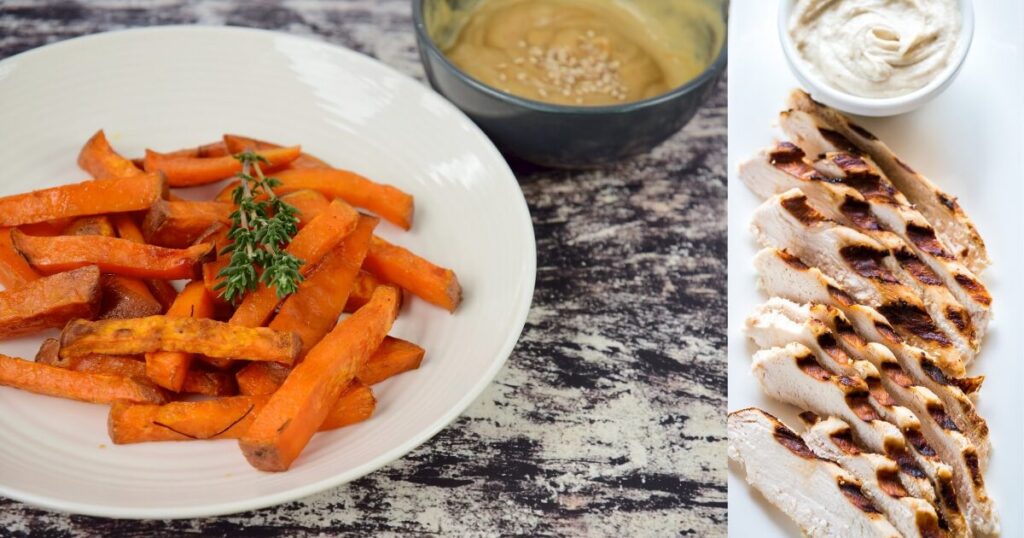
Tahini: The Magical Mediterranean Sauce - "Butter of the Middle East" [vegan, low-carb, keto friendly]
“Open Sesame”
"Open Sesame" (Arabic: افتح يا سمسم iftaḥ yā simsim) is a magical phrase in "Ali Baba and the Forty Thieves", a story found in the folk tale collection “One Thousand and One Nights”. In the tale, Ali Baba is at work collecting and cutting firewood in the forest, and he happens to overhear a group of 40 thieves visiting their treasure trove. The treasure is in a cave, the mouth of which is sealed by magic. It opens on the words "open sesame" and seals itself on the words "close sesame."
“Tahini” is the name for a condiment made from toasted ground hulled sesame - magical enough to open treasure-filled caves or to open a hungry mouth and delight the taste buds. It is served by itself or as a major ingredient in several iconic Middle Eastern dishes such as hummus, baba ghanoush (roasted eggplant dip), and halva (a dense dessert). Tahini is used in the cuisines of the Eastern Mediterranean, the South Caucasus, and the Middle East, as well as parts of North Africa.

The Origin Story of the Sesame Superhero
Sesame seed is an ancient food. Its believed by some to have originated in India “where maximum variability in genetic resources is available” (Pharmacogn Rev. 2014 Jul-Dec; 8(16): 147–155) though this is debated, with some evidence showing origins in South Africa as well (Bedigian, 2004; Kobayashi, 1986; Yol and Uzun, 2012). Whatever the case, it has been cultivated in India since 5000 BC, with references found on cuneiforms from 3500 BC. It’s also mentioned in 13-Century Arabic cookbooks.
No longer undercover, the humble sesame seed is now grown in different parts of the world and used in a variety of ways, culinary and medicinal, with tahini representing its incarnation in Middle Eastern cuisine.
In-Depth Description
It has the richness of a nut butter, but with a thinner consistency. In fact, compared to other nut and seed butters, sesame seeds have some of the highest oil content by weight (45-60 % by weight that resists oxidative rancidity) - which provides a texture that is silky smooth in addition to having a more mild taste - flavorful but not overpowering. Complementing other flavors and textures without losing its own essence or taste, tahini doesn’t mind playing in the background.
The term “tahini” might be a bit confusing, however, because it can be used to refer to just the plain sesame paste itself, or the lemony, garlicky sauce made from it. We use the latter as a dip for our made from scratch falafel, which offers a delightful contrast to the crunchy fried fritters. We also use it as a sauce on our shawarma (thinly slice marinated meats) and falafel pita sandwiches. Smothered on any of these, it offers a tangy accent and succulent soppy sauce that brings all the flavors together while adding its own into the mix.
And guess what...it’s super good for you in a superfood kinda way.

A Ketogenic Sauce [Low-Carb, High in Healthy Fat, Keto-Friendly]
Part of what makes tahini so rich and satisfying is that it is not a low-fat ingredient - it’s infused with deliciously rich oil. And these fats are the good kind - the omegas we’re told to consume. Finding a delicious and easy sauce to supplement the flavor of a meal, which contains no added sugar and is low in carbohydrates, can be hard to find, but tahini comes in for the rescue. Not to mention how versatile it is in dressing up veggies and meats alike.
That fact that its low in carbohydrates and contains a high amount of fats, makes it a fantastic addition to those following a ketogenic diet or low-carb diet. It tastes like an indulgence, but it will maintain your ketosis like an avocado massaged in butter and infused with MCT oil. Feel the ketones suffusing your body already. It’s easy to use in a pinch, but can be scaled up in a variety of ways if you have the time.
View: Ketogenic Menu
The Crème de la Crème [A Vegan Sauce]
A creamy texture can be hard to find when following a vegan diet. Coconut milk is a great option, but can sometimes be too heavy and the coconut-y flavor too overpowering for milder dishes. Many commercial non-dairy milks are nice, but can often be too thin to accomplish the task for which milk is often called upon. That’s where tahini comes in all Goldy Locks style and makes it just right.
Adding a touch of rich creaminess with healthy and satisfying fats, it can be added at a moments notice (without any blending required). Tahini won’t overwhelm. It will only accentuate.
View: Vegan Menu
Health Benefits to Help You “Crush It”
Like olive oil, or diamonds, sometimes a thing has to undergo intense crushing pressure before it’s full treasure is revealed:
“The nutrients of sesame seeds are better absorbed if they are ground or pulverized before consumption, as in tahini"
(Bedigian, 2004 in Economic Botany 58(3):329-353 · September 2004)
The life of a sesame seed has been crushed into the form of tahini so that you can crush yours!
Tahini’s other health benefits are that it is a wealthy source of essential vitamins and minerals, it’s high in amino acids, supports the regulation of blood pressure and cholesterol, can help balance hormones, improve skin health, and increases nutrient absorption.
Fit For a Queen
Sesame oil itself is popularly known as “Queen of Oilseeds” due to its high degree of resistance to oxidation and rancidity. From a U.S National Library of Medicine National Institutes of Health study:
[1] Sesame seed contains 50-60% of high quality oil which is rich in polyunsaturated fatty acids (PUFA) and natural antioxidants, sesamin, sesamolin and tocopherol homologues.[2] These bioactive components enhance the stability and keeping quality of sesame oil along with numerous health benefits. Sesame seeds are considered as valuable foods as they enhance the diet with the pleasing aroma and flavor and offer nutritional and physiological benefits.
- Bedigian D, Harlan JR. Evidence for cultivation of sesame in the ancient world. Econ Bot. 1986;40:137–54.
- Brar G, Ahuja KL. Sesame: its culture, genetics, breeding and biochemistry. Annu Rev Plant Sci. 1979;1:245–313.
More Health Benefits
This study goes on to list a number of other unique benefits of sesame seeds:
- Liver & Heart Health: “Recent studies on the antioxidant and anti-carcinogenic activities of sesame seed have greatly increased its applications in health food products that assert for liver and heart protection and tumor prevention.” (Cheng FC, Jinn TR, Hou RC, Tzen JT Int J Biomed Sci. 2006 Sep; 2(3):284-8.)
- Protein & Mineral Support: “Sesame seed is high in protein, vitamin B1, dietary fiber as well as an excellent source of phosphorous, iron, magnesium calcium, manganese, copper and zinc”
- Cholesterol & Blood Pressure Support: “In addition to these important nutrients, sesame seeds contain two unique substances, sesamin and sesamolin.”
“Both of these substances belong to a group of special beneficial fibers called lignans and have a cholesterol lowering effect in humans and prevent high blood pressure and increase vitamin E supplies in animals.”
- Shelf Life Longevity: “The antioxidative agents sesamin, sesamolin, sesamol, their glucosylated forms sesaminol glucosides and tocopherol make the oil very stable and therefore it has a long shelf life.”
- Antioxidants for Health: “Sesame seeds contain a group of phenylpropanoid compounds, namely lignans, an innate non-enzymatic antioxidant defense mechanism against reactive oxygen species which play a vital role in health promotion.”
- Digestive Health “Its high oil content not only lubricates the intestines, but nourishes all the internal viscera.”
From the Middle East To Beyond: The Many Uses of Tahinin
In the Middle East, tahini is viewed more as a utilitarian building block than a sophisticated condiment - like how we would use butter or mayonnaise. In fact, it is referred to as the “butter of the Middle East”, adding a denseness to both savory and sweet dishes (like ‘halva’) alike.
Though it might not be thought of as widely used as ketchup or mustard, tahini contains a versatility and richness of flavor that can be a wonderful addition in many contexts.
Though familiar in Lebanese, Turkish, & Armenian cuisines, tahini has uses that can go far beyond what is typically offered. The list below contains many general ideas on how to utilize this magical sauce. For greater detail, just do a search to find a variety of recipes available across the internet.
Spreads & Alternative to Peanut Butter: Just as addicting...
- In Greece, it is common to spread tahini on toast with honey or jam for breakfast
- Tahini & Jelly Sandwich: swap out the classic peanut butter layer with tahini or mix it up further with date molasses instead of traditional jam
- Just like you would with other nut butters, smear some tahini onto toasted bread along with raw honey or berries.
Meat & Sauce: Ladle it onto any variety of meats or fish
Fish Sauce: drizzle after cooking or use it in the cooking process as seen below:
- Coat fish in tahini and roast like a fish fillet. Sally Swift from “Splendid Table” suggests this very thing:
“It sort of has a similar effect to baking fish in salt. It creates a crust, and the only difference is that this is a crust that you can eat. It gets a little bit charred around the edges and it hardens up a little, and it has the effect of keeping all of the juices and moisture inside of the fish.”
Asian Noodle Sauce: meld together with ginger, garlic, and water
Salad dressing: by itself or blended
- Pair it with quinoa, or tofu or heartier salads
Pasta salad: replace the mayonnaise, tahini coats and flavors like a champ
Baking: Add depth to a variety of baked goods - quick breads, blondies, or cookies
- Pouring tahini into cakes and brownies creates neat swirling patterns with a nutty flavor
- Baking into cookies is somewhat similar to using peanut butter but also a little different
Dipping: a quick, ready-made dip for almost anything
- Raw Veggies/Crudité Platter
- Crackers
- Fries
Soup (hot or cold): stir into soup as a thickener
Smoothies: tahini does a wonderful job of adding thickness to smoothies
- Here’s another replacement for peanut butter: add tahini and banana, cinnamon and nutmeg, maybe with some berries on dates for a little more sweetness.
- It’s got protein
Curries, sautees, & stews: again, the creaminess cannot be denied, nor its subtle roasted flavor
Ice Cream or Frozen Yogurt: it can be a great to drizzle over ice cream - it kind of freezes of a little like “Magic Shell”, except a whole lot healthier





We hope you enjoyed this journey in learning about tahini and its applications. We hope it helps to fill your life with goodness and health!
Share with us your favorite ways to use this magical sauce!





